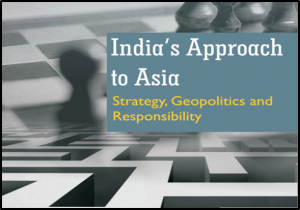
The book India’s Approach to Asia: Strategy, Geopolitics and Responsibility is the upshot of the 17th Asian Security Conference on the theme “Asian Security: Comprehending the Indian Approach” held in February 2015. This book consists of 30 chapters written by esteemed Scholars and Stalwarts of the IR domain. The main theme around which the book revolves is India. With the changing world order and regional setting, India’s own vision and role in shaping regional and international security order have changed. This book is divided into sub-parts- like Asian Regional Order, India and its Strategic Partnerships, Asian Economies and Resource Competition, the rise of China, Maritime Security in Asia, Cyber, Space, Biological, Chemical and Nuclear Security in Asia, Major Strategic Regions of Asia and Future Trends and Scenarios.
The book starts with an introductory chapter written by the Editor Namrata Goswami herself – talking about India’s Approach to Asia as a whole, how it evolved during Cold War- what it is now, what factors inspired India’s approach in the region and its foreign policy – how India has always tried to keep a balance between Realist and Liberal tendencies in its Security Strategy and policies for neighbours.
The first portion of the book talks about Asian Regional Order– discussing how India has transformed its approach towards the region – South Asia, a smooth shift from a liberal concept of Panchsheel to competing regionalism. The Foreign Policy of India has changed according to the changing times and that has been described vividly in this portion. India’s engagement with the regional groups and forming new ones has given it a chance to be a leader or target emerging issues of the region. India’s transformation from Look East to Act East, leaving behind the big-brother syndrome and emerging as an elder brother for the neighbour and extended neighbourhood highlights India’s adaptive attitude in foreign policy.
The second Portion discusses India’s Strategic Partnerships with major powers in the world including Russia, the US, Japan and Vietnam. Each Chapter traces out the historical background of the relations with India and how it evolved in the post-Cold War era. Each of these countries is a strategic partner of India in different domains such as defence, technology transfer, infrastructural development and this cooperation flourished after the Cold War ended and bloc politics disappeared.
The third Portion of the book focuses on India’s Policy Transformation from Look East to Act East and the importance of India’s North East region in it. India, in order to increase its cooperation with ASEAN and other neighbouring countries in the east, has inaugurated several infrastructural projects in the maritime, railways, roadways energy and other technological domains. Also, how terrorism is affecting different economies of Asia, how they are tackling it and what loss they have to bear in controlling it since with time, terrorism has expanded its reach and has diversified its networks everywhere.
The fourth Portion of the book revolves around China- India relations. Sino- Indian relations have never been easy and have been filled with betrayals, wars, territorial disputes and border skirmishes. The Post-Cold war era witnessed the rise of China-which is strong and advanced economically, politically, technologically and is desperate to be the regional as well as the global leader. Its swift modernisation and development in defence sector has become a matter of concern especially China’s active presence in the Indian Ocean Region. Also, China’s increasing presence in the region has given rise to territorial disputed with many countries including India. These arbitrary actions by the China have attracted the attention of developed countries too.
Fifth portion of the book deals with Maritime Security in Asia. It deals with the maritime interest of India and its constructive engagement with other regional actors including humanitarian missions. Indian Navy has been acting very dynamically in the region and has tried to change the image of India meaningfully. Further, it discusses the importance of the Bay of Bengal in the emerging concept of Indo-Pacific. It also discusses the role of India, China and Japan in the region.
The sixth portion discusses about Cyber, Space, Biological, Chemical and Nuclear Security in Asia. This portion talks about the legal aspect of the Cyber World and IoT, risks associated with it and what role governments can play in its development. Then it moves on to the space and its security. The Chapter discusses the regional associations and major power and their respective space programs. Next, this portion talks about biological weapons and how their easy availability to terrorist outfits has become a problem for the world. Further, how the proliferation of nuclear weapons in the Indian continent has altered the regional setting. Nuclear energy has become a means of deterrence. India, which is committed to the peaceful use of nuclear energy, is set to play an important role for nuclear disarmament as well as Asian nuclear order.
Seventh portion discusses India’s constructive engagements with different parts of Asia itself i.e, South Asia, South East Asia and Central Asia. India has tried to maintain strategic partnerships with the immediate and extended neighbourhood by engaging in different sectors simultaneously and creating an atmosphere of mutual benefit. India has from time to time brought changes in its foreign policies to revamp its relations with its neighbours.
The last portion of this book takes into account the futuristic perspective about Asia and India’s role in it. India has always believed in the participation of each and every country thus vouch for multilateral world order. There are some factors that affect India’s engagement in the region which have been discussed extensively in the Chapter.
Overall, the book revolves around India, its position in Asia, its engagement with the major powers of Indo-Pacific as well as with other parts such as Central and SE Asia. This book traces the quest which India possess for proving itself a worthy leader in the region, a elder brother and a positive alternative to a giant hegemon like China. Its extensive coverage of different sectors and special emphasis on India- China relations clarify more and more curious minds.













